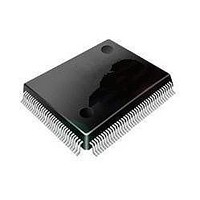ST92F120V1Q7 STMicroelectronics, ST92F120V1Q7 Datasheet - Page 252

ST92F120V1Q7
Manufacturer Part Number
ST92F120V1Q7
Description
Microcontrollers (MCU) Flash 128K SPI/I2C
Manufacturer
STMicroelectronics
Datasheet
1.ST92F120V9Q7.pdf
(325 pages)
Specifications of ST92F120V1Q7
Data Bus Width
8 bit, 16 bit
Program Memory Type
Flash
Program Memory Size
128 KB
Data Ram Size
4 KB
Interface Type
I2C, SPI
Maximum Clock Frequency
24 MHz
Number Of Programmable I/os
77
Number Of Timers
5
Maximum Operating Temperature
+ 105 C
Mounting Style
SMD/SMT
Package / Case
PQFP-100
Minimum Operating Temperature
- 40 C
On-chip Adc
8 bit, 16 Channel
Lead Free Status / Rohs Status
No
Available stocks
Company
Part Number
Manufacturer
Quantity
Price
Company:
Part Number:
ST92F120V1Q7
Manufacturer:
ST
Quantity:
6 765
Part Number:
ST92F120V1Q7
Manufacturer:
ST
Quantity:
20 000
Part Number:
ST92F120V1Q7C
Manufacturer:
ST
Quantity:
20 000
Company:
Part Number:
ST92F120V1Q7DTR
Manufacturer:
MAXIM
Quantity:
2 854
- Current page: 252 of 325
- Download datasheet (3Mb)
J1850 Byte Level Protocol Decoder (JBLPD)
J1850 BYTE LEVEL PROTOCOL DECODER (Cont’d)
10.8.5 Interrupt Features
The JBLPD has six interrupt sources that it han-
dles using the internal interrupts protocol. Other
two interrupt sources (REOB and TEOB) are relat-
ed to the DMA feature (See
Features).
No external interrupt channel is used by the
JBLPD.
The dedicated registers of the JBLPD should be
loaded with appropriate values to set the interrupt
vector (see the description of the IVR register), the
interrupt mask bits (see the description of the IMR
register) and the interrupt pending bits (see the de-
scription of the STATUS and PRLR registers).
The interrupt sources are as follows:
– The ERROR interrupt is generated when the ER-
– The TLA interrupt is generated when the trans-
– The EODM interrupt is generated when the
– The EOFM interrupt is generated when the
– The RDRF interrupt is generated when a com-
252/324
9
ROR bit of the STATUS register is set. This bit is
set when the following events occur: Transmitter
Timeout, Transmitter Data Underflow, Receiver
Data Overflow, Transmit Request Aborted, Re-
ceived Break Symbol, Cyclic Redundancy Check
Error, Invalid Frame Detect, Invalid Bit Detect (a
more detailed description of these events is giv-
en in the description of the ERROR register).
mitter loses the arbitration (a more detailed de-
scription of this condition is given in the TLA bit
description of the STATUS register).
JBLPD detects a passive level on the VPWI line
longer than the minimum time accepted by the
standard for the End Of Data symbol (a more de-
tailed description of this condition is given in the
EODM bit description of the STATUS register).
JBLPD detects a passive level on the VPWI line
longer than the minimum time accepted by the
standard for the End Of Frame symbol (a more
detailed description of this condition is given in
the EOFM bit description of the STATUS regis-
ter).
plete data byte has been received and placed in
Section 0.1.6 DMA
– The REOB (Receive End Of Block) interrupt is
– The TRDY interrupt is generated by two condi-
– The TEOB (Transmit End Of Block) interrupt is
10.8.5.1 Interrupt Management
To use the interrupt features the user has to follow
these steps:
– Set the correct priority level of the JBLPD
– Set the correct interrupt vector
– Reset the Pending bits
– Enable the required interrupt source
Note: It is strongly recommended to reset the
pending bits before un-masking the related inter-
rupt sources to avoid spurious interrupt requests.
The priority with respect the other ST9 peripherals
is programmable by the user setting the three
most significant bits of the Interrupt Priority Level
register (PRLR). The lowest interrupt priority is ob-
tained by setting all the bits (this priority level is
never acknowledged by the CPU and is equivalent
to disabling the interrupts of the JBLPD); the high-
est interrupt priority is programmed resetting the
bits. See the Interrupt and DMA chapters of the
datasheet for more details.
When the JBLPD interrupt priority is set, the prior-
ity between the internal interrupt sources is fixed
by hardware as shown in
the RXDATA register (see also the RDRF bit de-
scription of the STATUS register).
generated when receiving using DMA and the
last byte of a sequence of data is read from the
JBLPD.
tions: when the TXOP register is ready to accept
a new opcode for transmission; when the trans-
mit state machine accepts the opcode for trans-
mission (a more detailed description of this
condition is given in the TRDY bit description of
the STATUS register).
generated when transmitting using DMA and the
last byte of a sequence of data is written to the
JBLPD.
Table
5.
Related parts for ST92F120V1Q7
Image
Part Number
Description
Manufacturer
Datasheet
Request
R

Part Number:
Description:
8/16-bit Flash Mcu Family With Ram, Eeprom And J1850 Blpd
Manufacturer:
STMicroelectronics
Datasheet:

Part Number:
Description:
STMicroelectronics [RIPPLE-CARRY BINARY COUNTER/DIVIDERS]
Manufacturer:
STMicroelectronics
Datasheet:

Part Number:
Description:
STMicroelectronics [LIQUID-CRYSTAL DISPLAY DRIVERS]
Manufacturer:
STMicroelectronics
Datasheet:

Part Number:
Description:
BOARD EVAL FOR MEMS SENSORS
Manufacturer:
STMicroelectronics
Datasheet:

Part Number:
Description:
NPN TRANSISTOR POWER MODULE
Manufacturer:
STMicroelectronics
Datasheet:

Part Number:
Description:
TURBOSWITCH ULTRA-FAST HIGH VOLTAGE DIODE
Manufacturer:
STMicroelectronics
Datasheet:

Part Number:
Description:
Manufacturer:
STMicroelectronics
Datasheet:

Part Number:
Description:
DIODE / SCR MODULE
Manufacturer:
STMicroelectronics
Datasheet:

Part Number:
Description:
DIODE / SCR MODULE
Manufacturer:
STMicroelectronics
Datasheet:

Part Number:
Description:
Search -----> STE16N100
Manufacturer:
STMicroelectronics
Datasheet:

Part Number:
Description:
Search ---> STE53NA50
Manufacturer:
STMicroelectronics
Datasheet:

Part Number:
Description:
NPN Transistor Power Module
Manufacturer:
STMicroelectronics
Datasheet:











